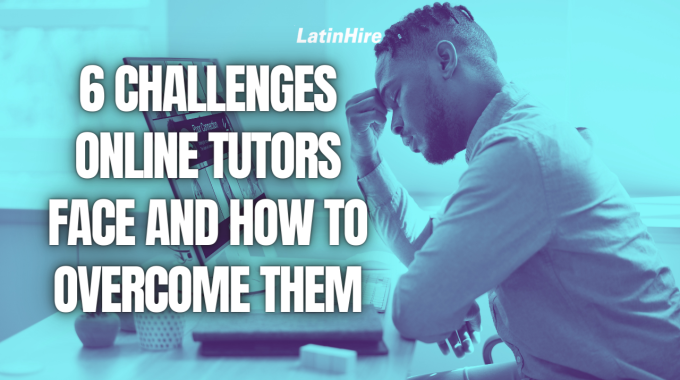Yesterday (March 9, 2025) marked the start of daylight saving time (DST)—a potential headache for…

6 Challenges Online Tutors Face and How to Overcome Them
Teaching online offers immense benefits of having a flexible schedule, location mobility, and saving on transportation costs. It allows tutors to reach a global audience and tailor their work hours to fit their lifestyles.
However, teaching online also presents unique challenges that can impact both tutors and students. These challenges range from technical difficulties and maintaining student engagement to managing diverse learning styles and dealing with the lack of in-person interaction.
Let’s take a look at some common obstacles faced in online tutoring and explore practical solutions to overcome them, ensuring a successful and enriching learning experience for all involved.
Challenge #1: Technical Difficulties

We’ve all experienced the frustration of unstable internet connections during an online class, leading to repeated questions like, “Can you hear me?” and “What about now?” While nobody wishes for these interruptions, they are inevitable when relying on the internet for lesson delivery. Although restarting your teaching platform or even your computer can sometimes resolve the issue, it consumes valuable tutoring time and disrupts the flow of the lesson.
Solutions for Technical Difficulties
First and foremost, online tutors should prioritize working in an environment with a stable internet connection, preferably using a wired connection or a reliable Wi-Fi network. It’s important to have a good data plan as a backup in case of internet service provider issues. If technical problems persist, consider switching internet providers or finding a location with a stronger signal. Additionally, familiarize yourself with troubleshooting steps and keep your teaching software up to date to minimize disruptions.
Challenge #2: Communication Barriers
The lack of face-to-face interaction in online tutoring can make it challenging to gauge student understanding, especially if students have their webcams turned off. Miscommunication can occur without visual cues, limiting non-verbal communication and making it harder to connect with students on a deeper level. On top of that, language barriers or different communication styles can further complicate interactions, making it essential for tutors to find effective ways to bridge these gaps.
Solutions for Communication Barriers
Encourage students to turn on their webcams to enhance personal connection and understanding. Provide plenty of opportunities for students to ask questions and offer regular feedback to them. Use visual aids such as screen sharing, virtual whiteboards, and presentation slides to clarify concepts. Incorporating asynchronous communication methods, such as discussion boards and email, is also beneficial as it allows students time to process information and formulate their responses.
Challenge #3: Engagement and Motivation

Keeping students engaged in a virtual environment can be challenging as distractions at home and in their surroundings can hinder focus. Students may feel isolated and less motivated without the social interaction and structure of a traditional classroom. Without the physical presence of peers and teachers, students may struggle to stay disciplined and proactive in their learning, impacting their overall academic performance and well-being.
Solutions for Engagement and Motivation
Incorporate interactive elements such as quizzes, polls, and games to make your online sessions more engaging. Set clear goals for your students and frequently check in with them to monitor their progress. Provide regular, constructive feedback to keep students motivated, and encourage them to create a structured and distraction-free learning space. Also, consider using breakout rooms for small group activities to foster interaction.
Challenge #4: Personalization and Adaptability
Adapting teaching methods to suit individual learning styles can be more difficult online. The lack of spontaneous interaction can make it harder to address students’ immediate needs and adjust your teaching approach on the fly. Online platforms can sometimes feel rigid, limiting the ability to offer the same level of tailored instruction as in-person settings.
Solutions for Personalization and Adaptability
Use diagnostic assessments to understand students’ strengths and weaknesses. Offer a variety of resources, such as videos, readings, and interactive exercises, to cater to different learning styles. Be flexible and ready to adjust your approach based on ongoing feedback and progress. If you have time, use personalized learning plans and one-on-one sessions to provide targeted support and address specific challenges.
Challenge #5: Building Relationships

Developing a rapport with students can be more challenging without in-person interaction. Trust and comfort levels may take longer to establish, impacting the overall learning experience. The absence of physical presence can make it harder for students to feel connected to their tutor and peers, potentially leading to a sense of isolation.
Solutions for Building Relationships
Start with icebreaker activities and regular check-ins to build rapport and create a sense of community. Show empathy and patience, and strive to create a supportive and encouraging learning environment. Use consistent communication channels, such as Google classroom or messaging apps, to maintain regular contact with your students. Celebrate achievements and milestones to build a positive and motivating atmosphere.
Challenge #6: Assessment and Feedback
Monitoring progress and providing effective feedback can be more complicated in online classrooms. The virtual format can lead to delays in feedback, reducing its immediacy and impact. Ensuring academic integrity during assessments presents an additional challenge, as the online environment offers more opportunities for dishonesty, such as cheating or plagiarism. This can undermine the credibility and the reliability of the results.
Solutions for Assessment and Feedback
Use formative assessments like quizzes and assignments to track progress. Provide detailed, constructive feedback regularly to guide improvement. Use online proctoring tools or design open-book assessments to maintain academic integrity. Implement project-based assignments that allow students to demonstrate their understanding in practical, real-world contexts where the answers cannot be found by a simple Google search.
What are some other challenges you’ve come across as an online tutor and how do you overcome them? Share your experiences in the comments below!



